| TI-V77N Heatsink From All
Angles |
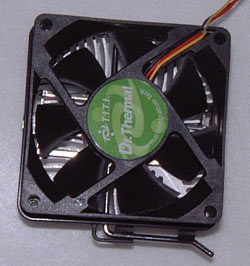 |
The Fan:
The unlabeled fan is reported to
spin at 5000RPM and considering the amount of noise it generates this
would seem to be a fair
number. The fan is 60mm in size and 25mm thick. Apart from the odd
arrangement of fan blades and orientation of the entire unit
it is otherwise very standard. The fan connects to the power
source via a molex pass thru cable, and uses a small three-pin connector
to deliver the RPM signal to the fan header. |
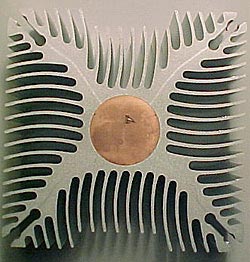 |
Heatsink Top:
The heatsink top is just
about the same as the heatsink bottom, but bear with us for a moment. Each
side of the TI-V77N has 15 curved fins that range in length from 4mm to
23mm. We were impressed to see that the fins were scalloped on both side
to increase surface area and promote turbulence. Also note that screw
holes have been made in the extrusion to accept both 70mm and 60mm
configurations. The central copper core appears to be 20mm in
diameter. |
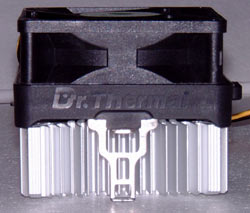 |
Side A:
No matter how much we would all
like to see tooless heatsinks become standard, the TI-V77N does require a
small screw driver at some point. Much of the tensioning is taken up by
the small lever on the left hand side. Each of the 15 fins are roughly
0.9mm thick and 21mm tall. The fins are spaced widely at 3mm distances.
|
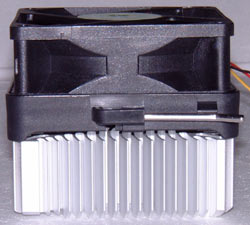 |
Side B:
The fan shroud which
supports the unlabeled fan 6.5mm above the top of the heatsink also doubles as a
frame for the attachment mechanism and lever. The base of the heatsink has
a bevel to help keep fingers from being sliced up. The base is undercut
2mm to clear the socket cam arm. |
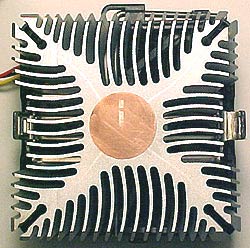 |
Heatsink Base:
Looking at the base
of the TI-V77N is like looking at the top of it. Unlike traditional
extruded heatsinks this one is essentially sitting on its side. The base finish
is very good, and the left hand side undercut 2mm for socket cam
arm clearance. The heatsink comes with a small patch of gray wax-like
phase change material over the copper core. We removed this material
before conducting our thermal tests |


